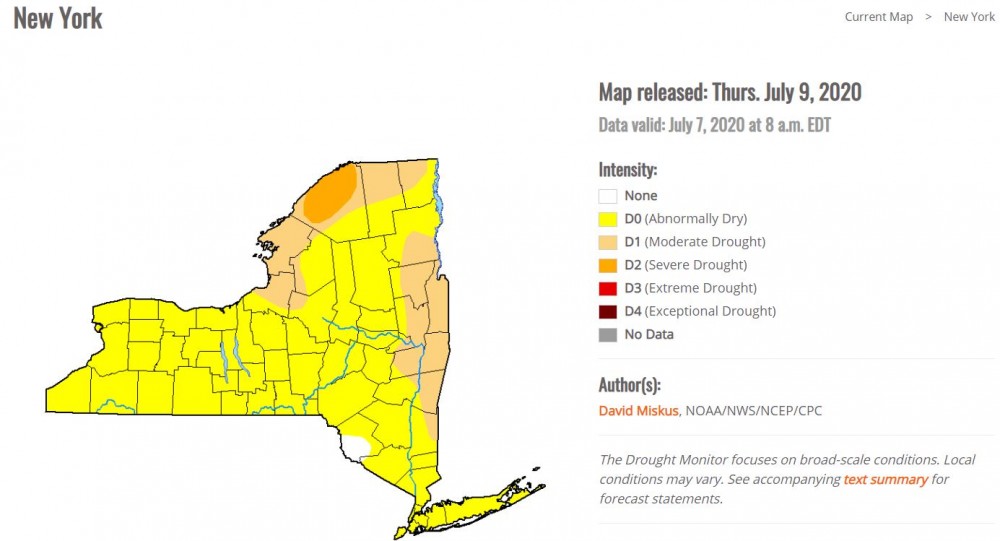Management of Drought on Pasture
Amy Barkley, Livestock Specialist
Southwest New York Dairy, Livestock and Field Crops Program
SWNY is beginning to encounter very dry conditions, where precipitation has been isolated to pop-up showers and looking to the sky for rain has started to become the new normal. As of July 9, the US Drought Monitor, indicated that all of SWNY is abnormally dry. Just last week, only the eastern side of Steuben County was listed in this classification, and a week prior to that, the condition was isolated to the Finger Lakes region. Dry conditions hit pastures hardest first. Proper forage management to ensure sustainable nutrition for livestock as well as vitality of the pasture should be a priority, especially if those pastures are a primary source of livestock feed.
This article lists strategies for pasture and livestock, and was adapted from Doo-Hong Min, Michigan State University Extension and Derrell Peel, Oklahoma State University by Dr. Mike Baker.

Pasture
1. Minimize overgrazing. Overgrazed pastures weaken plants, expose soil to more heating
and loss of moisture. If you normally leave 3" of when rotational grazing increase that to
>5". This will help forage plants recover from drought stress and regrow faster next
spring.
2. Avoid clipping. In dry conditions, clipping like overgrazing can weaken plants and
remove insulation effect, thereby drying the soil further.
3. Use sacrifice paddock(s). Instead of grazing every pasture, set aside a sacrifice paddock
where hay is fed to minimize severe drought damage. This sacrifice paddock should be
the old, low yielding/quality pasture that needs to be renovated or reseeded.
4. Watch U.S. drought outlook. Keeping track of the forecast may help you plan your next
move when managing pasture lands. The U.S Drought Monitor is a useful tool to get an
idea about current drought conditions and the impact it may have in the short and long
term.
5. Apply fertilizer. Right after a drought-ending rain, applying nitrogen fertilizer (50
pounds N per acre) can help the drought-stressed grass hay fields and pasture recover
faster and store more root reserves for the long winter. Soils should be tested for
phosphorus and potassium and amended as required.
6. Plant cool-season annual forages to extend grazing season. Some producers plant
cool-season annuals such as forage brassicas (turnip, forage rape or kale) and small grains
(rye, wheat or oats) to extend grazing season. Although forage brassicas are not drought
tolerant crops, they can be planted in late summer.
7. Control stubble height. To restore healthy forage stands, it is important not to graze or
harvest drought-stressed forage plants too short in the fall. It is desirable to leave six
inches of stubble before entering winter. This also helps to catch moisture replenishing
snow and encourage re-growth in early spring.
Livestock
1. Identify older or cows without a calf that are likely culling candidates and consider
culling early. Cull cow prices are seasonally higher now than they will be later in the
year. Early pregnancy testing can help identify cows that could be culled early.
2. Make a priority list of how additional liquidation will be implemented if
necessary. This should include older and open cows, growing replacement heifers,
pregnant heifers, mature cows and so on.
3. The list should include action triggers, which could be specific dates or based on forage
conditions, that will initiate the next phase of liquidation.
4. Early weaning of suckling calves will reduce forage requirements of lactating cows and
stretch limited forage reserves this summer and fall. These calves may be marketed early
or moved into a drylot or semi-confinement backgrounding program. The feasibility of
early weaning must evaluate overall economic potential as well as the availability of
facilities, labor and equipment to feed and care for calves in a growing program. In
general, supplemental feed supplies are plentiful and inexpensive this year and may
provide more flexibility for cattle producers to stretch forage supplies.
5. The tradeoff between buying feed or liquidating animals is always economically tricky
and inevitably wrapped in emotion that can cloud sound decision-making.
According to Dr. Peel: "Failure to plan for deteriorating drought conditions will lead to
easier decision-making…simply because fewer alternatives will be available."
Upcoming Events
WNY Pastureland Conversion & Soil Health Field Day
July 16, 2025
Middleport, NY
Join American Farmland Trust for the Western New York Soil Health Field Day on July 16, 2025, at Zeliff Farm in Middleport, NY, from 9:00 AM-3:15 PM. Learn about pasture conversion, soil health benchmarking, biochar in grazing systems, and best grazing practices. Plus, enjoy hands-on demos with the NY Soil Health Trailer, drones, and cover crops! Check out the attached agenda for more information about the field day and REGISTER HERE. Zeliff Farms is a regenerative beef operation who has recently partnered with AFT on outreach and education to farmers including learning circles and evaluating biochar effects on soil health.
IPM Strategies to Protect Corn and Soybean Seed in NY
July 30, 2025
Hamburg , NY
SWNYDLFC and Cornell IPM are hosting a grower meeting to discuss integrated pest management strategies for protecting corn and soybean seed in New York.
FAMACHA Training for Sheep and Goat producers in Woodhull NY
August 13, 2025 : FAMACHA Training in Woodhull
Woodhull, NY
Join us for a discussion and hands-on training for internal parasite integrated pest management in sheep and goats. Certification is available to all students participating in the workshop.
Announcements
No announcements at this time.





